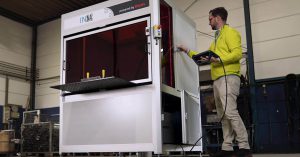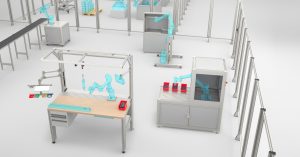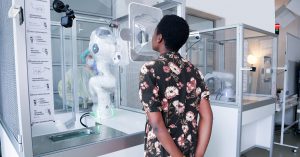Medical labs are having to contend with a serious skills shortage.
This situation is being further compounded by demographic change – more than two thirds of laboratory medicine specialists in Germany are now over the age of 50. In hospitals, a quarter of medical technical assistants (MTAs) are also in this age group, while around half are at least 45 years old. The majority of lab employees will therefore be retiring in the not-too-distant future. And yet, at the same time, our ageing society means there is a growing need for medical tests and an increasing demand for test capacity. Even today, eight people are generally required to handle 4500 samples per shift – and 87 percent of German labs already don’t have the staff they need to achieve this throughput. So who will process laboratory samples in the near future?
Action is therefore urgently required to find solutions to this challenge. And this is exactly where ASR600 – the smart robotic cell developed by Munich-based company robominds – comes in. At the heart of the robotic cell is robobrain® technology, which is based on artificial intelligence. This is combined with suitable components supplied by technology partners Universal Robots, item, the Zimmer Group and SICK to create an all-in-one solution. As a result, flexible, smart automation is used to identify and sort samples. No programming is required, so it’s easy for labs to start using the technology.
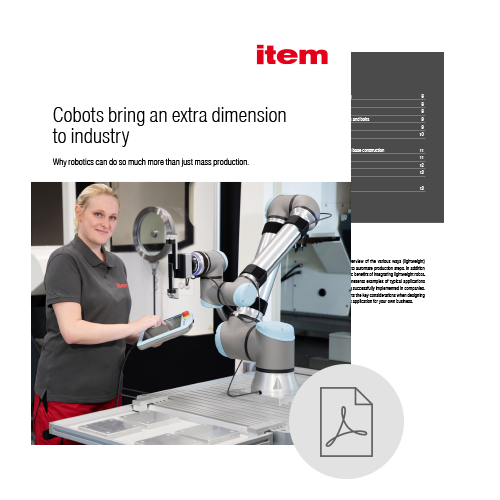
An overview of robot applications
Read our white paper to discover specific applications and other advantages of robotics in industry – and explore why lightweight robotics is a particularly worthwhile investment for small and medium-sized enterprises.
GO TO THE DOWNLOAD
Intelligence, skills and the ability to see – this is how smart cobots can be
robominds, which was established in 2016 and currently has around 30 employees, works on the principle of “Every robot needs a brain“. What exactly does this mean? “We give robots a brain and the ability to see. This makes it easy for anybody to get started with robotics. You don’t need any programming skills – absolutely anybody can operate the robot,” explains Christian Fenk, Chief Sales Officer at robominds. When it comes to innovation, the robominds team believes that a technology is only truly innovative if it is not only fundamentally possible, but can also be put into use without the need for any specialist know-how. And that’s certainly true of the robominds technology. At the heart of the solution is robobrain® – an AI-based control platform that gives the robot its “brain” or intelligence. The robot obtains optical input through its “eye” – the industrial 2D/3D camera robobrain.eye. While hand-eye coordination posed a major challenge in robotics for a long time, the robominds applications give cobots the ability to see, identify and grasp objects. This is obviously dependent on the cobots being equipped with the appropriate end effectors, but the robominds products can be combined with hardware from any manufacturer.
Another highlight is that you don’t need to teach the cobots what to do first, because they have already been trained in the AI skills and can therefore be used straight away.
The third product in the intelligent robotics range is robobrain.skills – the customised skills that enable robots to perform specific tasks. Examples include the Smart Item Detection Skill (generic detection of parts ranging from small to medium-sized objects), the Smart Parallel Picking Skill (recognition of small to medium-sized parts and handling them with two-finger grippers) and the Sample Tube Detection Skill (recognition and sorting of samples in a rack according to size and colour). The last of these examples was developed for the ASR600 robotic cell. The skills can also be flexibly customised as needed. Thanks to this interaction, tasks are automated without any need whatsoever for programming knowledge. Another highlight is that you don’t need to teach the cobots what to do first, because they have already been trained in the AI skills and can therefore be used straight away.
Smart, flexible robots play to their strengths in the lab
To create an efficient and reliable end-to-end solution, you need the right combination of individual components and the appropriate interaction between them. In the case of the ASR600 products, robobrain® – the control base – is combined with Line XMS from item for the enclosure, two Ur5e cobots from Universal Robots, safety technology from SICK and grippers from the Zimmer Group. “Our key contribution was a specially trained network that has been optimised to sort and separate blood, urine, stool and tissue samples,” Fenk adds. “Separation” refers to the fact that various sample types are in tubes with caps of different colours. These therefore need to be identified and sorted accordingly. Given the many different types of tube, which are stipulated by technical standards, this is a highly complex task. As a general rule, labs process 34 different sample types – and this is why standardised automation has previously been impossible.
The cobots are also each equipped with a barcode scanner. This means both that patient data is assigned correctly and that the code quality is checked.
The situation with this robotic cell for the automated handling of samples is very different, however. Thanks to the skills that AI has given them, the cobots are capable of separating the sample tubes single-handedly and reacting flexibly. This means they can process up to 600 samples per hour. Sample tube diameters ranging from 5 to 80 mm can be supported. The cobots are also each equipped with a barcode scanner. This means both that patient data is assigned correctly and that the code quality is checked. This directly ensures that the separate automated test facility in the lab can process the barcodes later on. The cell therefore also acts as a quality gate that determines whether or not the sample tube is forwarded to the next process step. Thanks to the straightforward user interface, it is really easy for any laboratory worker to use the ASR600, even if they have no prior knowledge of robotics.
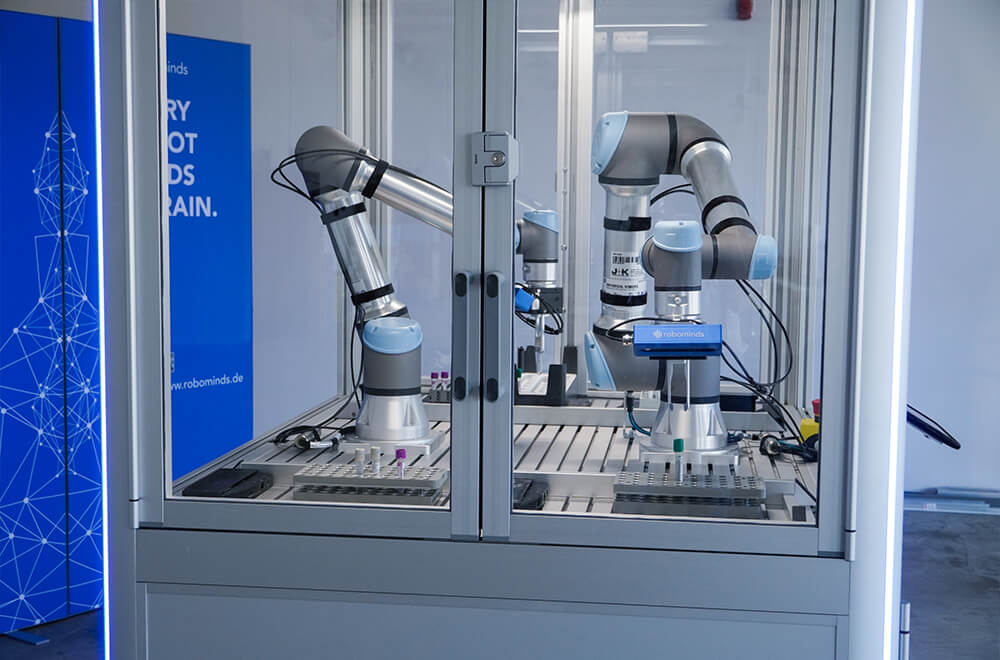
Ideally set up to meet all requirements thanks to the item modular design concept
It was primarily in the interests of safety and hygiene that the decision was taken to opt for an enclosed robotic cell in the form of a machine cabin. The advantages of Line XMS really came to the fore here. These include integrated cable conduits and easy-to-clean surfaces – features that fundamentally make Profiles XMS the perfect starting point for constructing machine cabins for clean production. Another key advantage was the modular design concept shared by all item profiles. Fenk has been very impressed by their qualities: “With item, I have an outstanding Building Kit System at my disposal. I can make my construction taller, smaller, wider or slimmer, and adapt it to suit the specific process in question. This means it’s really quick and easy for me to take the mechanical world to my laboratory customer, wherever and in whatever form they need it. That’s very pleasing!” Thanks to its modular concept, the robotic cell can easily be set up to suit the specific requirements in a particular laboratory. A lot comes down to throughput and doorway dimensions. It’s also really easy to make modifications at any time. If, for example, circumstances dictate that only a single cobot is needed on a particular occasion, all it takes is a few swift moves to remove one of the cobots and reposition the other one. The AI adjusts automatically to the changes that have been made – this is a perfect example of how well aligned the robominds and item solutions are.
The great thing about item is that even special requests are delivered exactly as we want them. All that’s left for us to do is screw it all together on site. This means the cell was built in next to no time.
robominds uses the item Building Kit System for robotic solutions for other projects, too, and appreciates being able to turn to companies in the German item pluspartner network. “I can rely on the same high quality for every project. We develop the robot’s intelligence and can then take advantage of the partner network to help us integrate it and scale it as required. Equally, customers have access to a local partner and support. We take exactly the same approach when it comes to the robot hardware,” Fenk explains. In the case of the robotic cell for laboratories, robominds turned directly to item once it had produced a preliminary design with the help of the item Engineeringtool. It was during this collaboration process that the finishing touches were put to the cell. “The great thing about item is that special requests are also delivered exactly as we want them. This means the cell was built in next to no time. The robots were then added, using mounting plates so that the robots fitted to the standard profile,” Fenk reports.
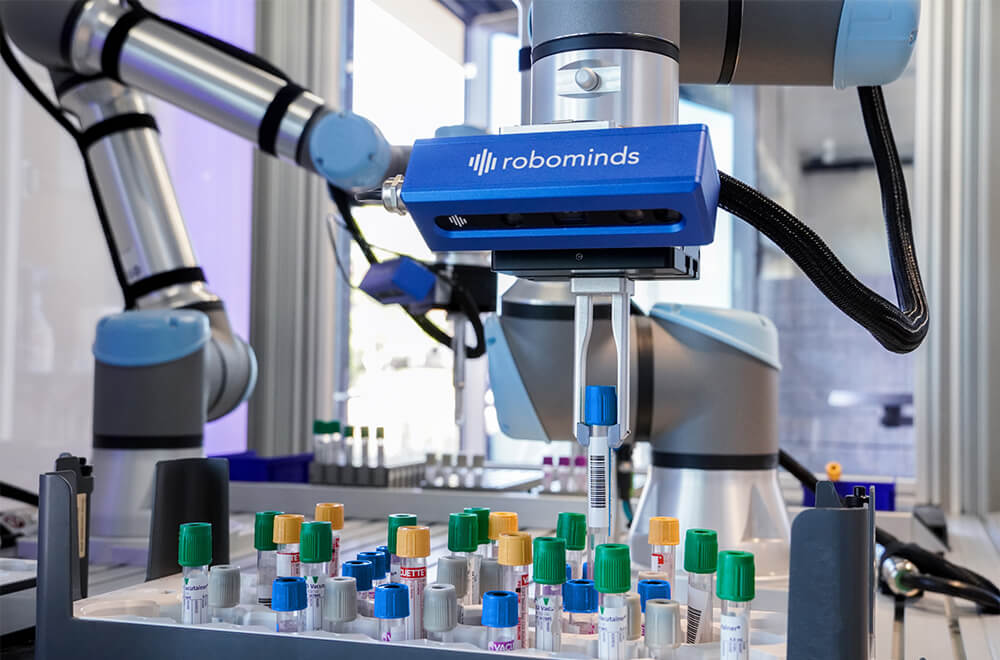
New form of laboratory automation premiered at analytica
Between 21 and 24 June 2022, robominds presented its robotic cell to the professional public at analytica, the world’s leading trade fair for lab technology, analysis and biotechnology. It quickly became apparent that there is a huge need for automation, not only in medical labs, but also in many related sectors. Companies had sought out detailed information in advance and arrived at the trade fair stand with specific ideas already in mind. Initial projects relating to wastewater samples, food tests and the analysis of yeast cultures for a brewery, for example, were all set in motion at the trade fair. Fenk highlights the relevance of the concept: “The intensive discussions also show how strong the demand is in various sectors. The crucial point is that AI has understood what a sample is and what it needs to do with it. It doesn’t actually matter whether it’s a blood sample or a water sample – nothing needs to be reprogrammed to account for such differences.” It will therefore be fascinating to see what other robotic applications emerge in this area.
Want all the latest updates on innovative robotics applications? Simply subscribe to the item blog by completing the box at the top right.


